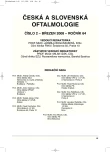Treatment for Recurrent Pterygium
Authors:
N. Jirásková; P. Rozsíval
Authors‘ workplace:
Oční klinika Lékařské fakulty Univerzity Karlovy a Fakultní nemocnice, Hradec Králové
přednosta prof. MUDr. P. Rozsíval, CSc.
Published in:
Čes. a slov. Oftal., 64, 2008, No. 2, p. 68-70
Overview
Our objective was to evaluate the postoperative outcomes of the surgical treatment for recurrent pterygia. Twelve eyes of 10 patients operated on for recurrent pterygia at the Department of Ophthalmology, University Hospital Hradec Kralove, Czech Republic, were involved in this study. All surgeries were done under the local anesthesia. The pterygium head was undermined and removed by dissection to reach the clear corneal lamelae. The pterygium body was thoroughly removed with extensive dissection of scared pathological tissue. In 3 eyes, the Mitomycin C 0.004 % solution was applied. Preserved human amniotic membrane was placed over the corneal and conjunctival defects and sutured with 8/0 Vicryl interrupted sutures. Postoperative results were good; in 11 eyes we did not observe the true corneal recurrence of fibrovascular tissue. In one eye only, the lamellar sclerokeratoplasty was necessary to perform because of the recurrence of pterygium.
Recurrent pterygium exhibits a more aggressive, fibrovascular growth pattern, leading to the corneal and conjunctival scarring and limbal stem cells deficiency. Proper excision of pathological tissue with amniotic membrane transplantation and/or Mitomycin C represents an alternative surgical method with good final outcomes.
Key words:
recurrent pterygium, surgical treatment, amniotic membrane
Sources
1. Dua, SH., Azuara-Blanco, A.: Amniotic membrane transplantation, Br J Ophthalmol., 83, 1999: 748–752.
2. Filipec, M.: Onemocnění spojivky. In Kraus, H. a kol., Kompendium očního lékařství, Praha, Grada, 1997, s. 71–72.
3. Holland, EJ., Schwartz, GS.: Changing Concepts in the Management of Severe Ocular Surface Disease over Twenty-five Years, Cornea., 19, 2000, 5: 688–698.
4. Jirásková, N.: Transplantace amniové membrány v léčbě patologických stavů předního segmentu oka. In Rozsíval, P.: Trendy soudobé oftalmologie, Praha, Galén, 2005, s. 255–256.
5. Miyai, T., Hara, R., Nejima, R.: Limbal Allograft, Amniotic Membrane Transplantation, and Intraoperative Mitomycin C for Recurrent Pterygium, Ophthalmology., 112, 2005: 1263–1267.
6. Shimmura, S., Tsubota, K.: Ocular surface reconstruction update, Current Opinion in Ophthalmology, 2002, 13: 213–219.
7. Ti, S., Tseng, S.C.G.: Management of primary and recurrent pterygium using amniotic membrane transplantation, Current Opinion in Ophthalmology, 2002, 13: 204–212.
8. Solomon, A., Pires, R.T.F., Tseng, S.C.G.: Amniotic Membrane Transplantation after Extensive Removal of Primary and Recurrent Pterygia, Ophthalmology, 2001, 108: 449–460.
Labels
OphthalmologyArticle was published in
Czech and Slovak Ophthalmology

2008 Issue 2
Most read in this issue
- The Application of the Autologous Serum Eye Drops Results in Significant Improvement of the Conjunctival Status in Patients with the Dry Eye Syndrome
- Treatment for Recurrent Pterygium
- Spontaneous Premacular Hemorrhage
- Applying the DNA Diagnostics in Patients with Superficial Keratitis of Viral Origin
